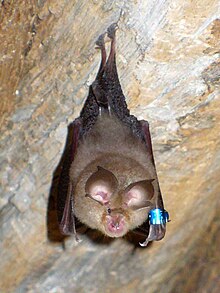Rhinolophus
| Horseshoe bats | |
|---|---|
 |
|
| Lesser horseshoe bat (Rhinolophus hipposideros) | |
| Scientific classification | |
| Kingdom: | Animalia |
| Phylum: | Chordata |
| Class: | Mammalia |
| Order: | Chiroptera |
| Suborder: | Yinpterochiroptera |
| Family: |
Rhinolophidae Gray, 1825 |
| Genus: |
Rhinolophus Lacépède, 1799 |
| Type species | |
|
Vespertilio ferrum-equinum Schreber, 1774 |
|
| Species | |
|
See text. |
|
See text.
Horseshoe bats make up the bat family Rhinolophidae. In addition to the single living genus, Rhinolophus, one extinct genus, Palaeonycteris, has been recognized. The closely related Hipposideridae are sometimes included within the horseshoe bats as a subfamily, Hipposiderinae. Both families are classified in the suborder Yinpterochiroptera or Pteropodiformes and were previously included in Microchiroptera.
All horseshoe bats have leaf-like, horseshoe-shaped protuberances on their noses. In the related Hipposideridae, these protuberances are leaf- or spear-like. They emit echolocation calls through these structures, which may serve to focus the sound. Their hind limbs are not well developed, so they cannot walk on all fours; conversely, their wings are broad, making their flight particularly agile. Most rhinolophids are dull brown or reddish-brown in color. They vary in size from 2.5 to 14 cm in head-body length, and 4.0 to 120 g in weight. Their dental formula is 1.1.1-2.32.1.2-3.3.
The females have a pair of mammary glands and two "false nipples" above and to the side of the genital opening, to which newborn bats cling for a few days after birth.
Rhinolophids inhabit temperate and tropical regions of southern Europe, Africa, and Asia south to northern and eastern Australia. All species are insectivorous, capturing insects in flight. Their roost habits are diverse; some species are found in large colonies in caves, some prefer hollow trees, and others sleep in the open, among the branches of trees. Members of northern populations may hibernate during the winter, while a few are known to aestivate; at least one species is migratory. Like many Vespertilionidae bats, females of some rhinolophid species mate during the fall and store the sperm over the winter, conceiving and gestating young beginning in the spring.
...
Wikipedia
